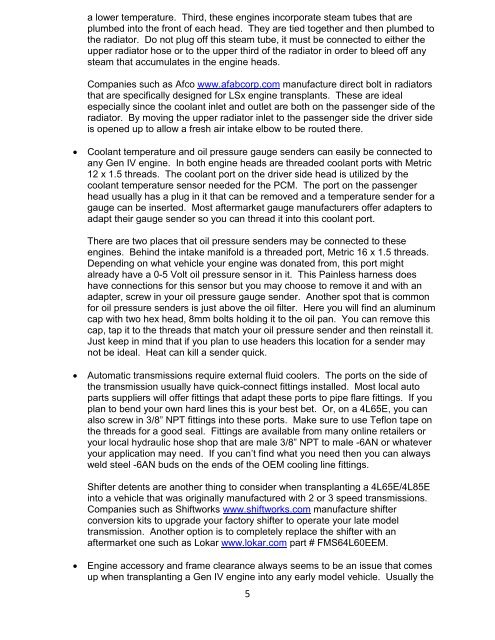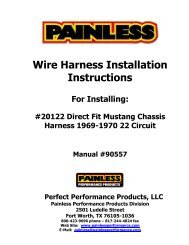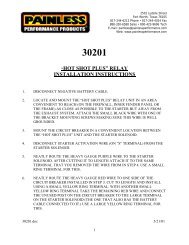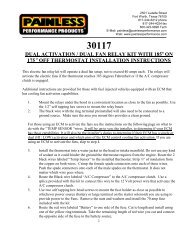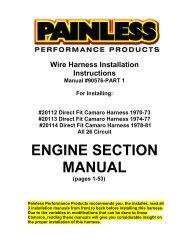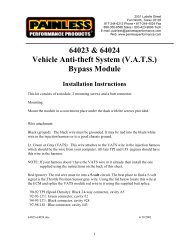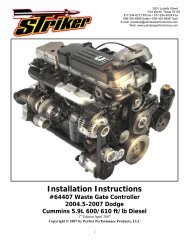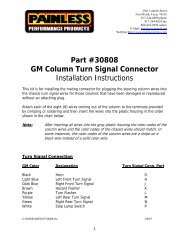UP LS2 LS3 L99 w/4L65E 4L70E 4L80E 4L85E Fuel Injection ...
UP LS2 LS3 L99 w/4L65E 4L70E 4L80E 4L85E Fuel Injection ...
UP LS2 LS3 L99 w/4L65E 4L70E 4L80E 4L85E Fuel Injection ...
Create successful ePaper yourself
Turn your PDF publications into a flip-book with our unique Google optimized e-Paper software.
a lower temperature. Third, these engines incorporate steam tubes that areplumbed into the front of each head. They are tied together and then plumbed tothe radiator. Do not plug off this steam tube, it must be connected to either theupper radiator hose or to the upper third of the radiator in order to bleed off anysteam that accumulates in the engine heads.Companies such as Afco www.afabcorp.com manufacture direct bolt in radiatorsthat are specifically designed for LSx engine transplants. These are idealespecially since the coolant inlet and outlet are both on the passenger side of theradiator. By moving the upper radiator inlet to the passenger side the driver sideis opened up to allow a fresh air intake elbow to be routed there.• Coolant temperature and oil pressure gauge senders can easily be connected toany Gen IV engine. In both engine heads are threaded coolant ports with Metric12 x 1.5 threads. The coolant port on the driver side head is utilized by thecoolant temperature sensor needed for the PCM. The port on the passengerhead usually has a plug in it that can be removed and a temperature sender for agauge can be inserted. Most aftermarket gauge manufacturers offer adapters toadapt their gauge sender so you can thread it into this coolant port.There are two places that oil pressure senders may be connected to theseengines. Behind the intake manifold is a threaded port, Metric 16 x 1.5 threads.Depending on what vehicle your engine was donated from, this port mightalready have a 0-5 Volt oil pressure sensor in it. This Painless harness doeshave connections for this sensor but you may choose to remove it and with anadapter, screw in your oil pressure gauge sender. Another spot that is commonfor oil pressure senders is just above the oil filter. Here you will find an aluminumcap with two hex head, 8mm bolts holding it to the oil pan. You can remove thiscap, tap it to the threads that match your oil pressure sender and then reinstall it.Just keep in mind that if you plan to use headers this location for a sender maynot be ideal. Heat can kill a sender quick.• Automatic transmissions require external fluid coolers. The ports on the side ofthe transmission usually have quick-connect fittings installed. Most local autoparts suppliers will offer fittings that adapt these ports to pipe flare fittings. If youplan to bend your own hard lines this is your best bet. Or, on a <strong>4L65E</strong>, you canalso screw in 3/8” NPT fittings into these ports. Make sure to use Teflon tape onthe threads for a good seal. Fittings are available from many online retailers oryour local hydraulic hose shop that are male 3/8” NPT to male -6AN or whateveryour application may need. If you can’t find what you need then you can alwaysweld steel -6AN buds on the ends of the OEM cooling line fittings.Shifter detents are another thing to consider when transplanting a <strong>4L65E</strong>/<strong>4L85E</strong>into a vehicle that was originally manufactured with 2 or 3 speed transmissions.Companies such as Shiftworks www.shiftworks.com manufacture shifterconversion kits to upgrade your factory shifter to operate your late modeltransmission. Another option is to completely replace the shifter with anaftermarket one such as Lokar www.lokar.com part # FMS64L60EEM.• Engine accessory and frame clearance always seems to be an issue that comesup when transplanting a Gen IV engine into any early model vehicle. Usually the5


